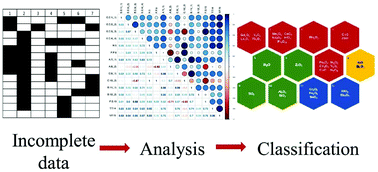Our official English website, www.x-mol.net, welcomes your
feedback! (Note: you will need to create a separate account there.)
How the toxicity of nanomaterials towards different species could be simultaneously evaluated: a novel multi-nano-read-across approach
Nanoscale ( IF 5.8 ) Pub Date : 2017-11-08 00:00:00 , DOI: 10.1039/c7nr05618d Natalia Sizochenko 1, 2, 3, 4, 5 , Alicja Mikolajczyk 1, 2, 3, 4, 5 , Karolina Jagiello 1, 2, 3, 4, 5 , Tomasz Puzyn 1, 2, 3, 4, 5 , Jerzy Leszczynski 6, 7, 8, 9, 10 , Bakhtiyor Rasulev 6, 7, 8, 9, 10
Nanoscale ( IF 5.8 ) Pub Date : 2017-11-08 00:00:00 , DOI: 10.1039/c7nr05618d Natalia Sizochenko 1, 2, 3, 4, 5 , Alicja Mikolajczyk 1, 2, 3, 4, 5 , Karolina Jagiello 1, 2, 3, 4, 5 , Tomasz Puzyn 1, 2, 3, 4, 5 , Jerzy Leszczynski 6, 7, 8, 9, 10 , Bakhtiyor Rasulev 6, 7, 8, 9, 10
Affiliation

|
Application of predictive modeling approaches can solve the problem of missing data. Numerous studies have investigated the effects of missing values on qualitative or quantitative modeling, but only a few studies have discussed it for the case of applications in nanotechnology-related data. The present study is aimed at the development of a multi-nano-read-across modeling technique that helps in predicting the toxicity of different species such as bacteria, algae, protozoa, and mammalian cell lines. Herein, the experimental toxicity of 184 metal and silica oxide (30 unique chemical types) nanoparticles from 15 datasets is analyzed. A hybrid quantitative multi-nano-read-across approach that combines interspecies correlation analysis and self-organizing map analysis is developed. In the first step, hidden patterns of toxicity among nanoparticles are identified using a combination of methods. Subsequently, the developed model based on categorization of the toxicity of the metal oxide nanoparticle outcomes is evaluated via the combination of supervised and unsupervised machine learning techniques to determine the underlying factors responsible for the toxicity.
中文翻译:

如何同时评估纳米材料对不同物种的毒性:一种新颖的多纳米交叉读取方法
预测建模方法的应用可以解决数据丢失的问题。许多研究已经研究了缺失值对定性或定量建模的影响,但是只有少数研究针对纳米技术相关数据中的应用进行了讨论。本研究旨在开发一种多纳米交叉读取建模技术,该技术可帮助预测细菌,藻类,原生动物和哺乳动物细胞系等不同物种的毒性。在本文中,分析了来自15个数据集的184种金属和二氧化硅(30种独特的化学类型)纳米粒子的实验毒性。结合种间相关性分析和自组织图谱分析的混合定量多纳米阅读跨方法。在第一步中 纳米粒子之间隐藏的毒性模式可通过多种方法加以识别。随后,评估了基于金属氧化物纳米颗粒结果毒性分类的已开发模型通过有监督和无监督机器学习技术的结合来确定造成毒性的潜在因素。
更新日期:2017-11-23
中文翻译:

如何同时评估纳米材料对不同物种的毒性:一种新颖的多纳米交叉读取方法
预测建模方法的应用可以解决数据丢失的问题。许多研究已经研究了缺失值对定性或定量建模的影响,但是只有少数研究针对纳米技术相关数据中的应用进行了讨论。本研究旨在开发一种多纳米交叉读取建模技术,该技术可帮助预测细菌,藻类,原生动物和哺乳动物细胞系等不同物种的毒性。在本文中,分析了来自15个数据集的184种金属和二氧化硅(30种独特的化学类型)纳米粒子的实验毒性。结合种间相关性分析和自组织图谱分析的混合定量多纳米阅读跨方法。在第一步中 纳米粒子之间隐藏的毒性模式可通过多种方法加以识别。随后,评估了基于金属氧化物纳米颗粒结果毒性分类的已开发模型通过有监督和无监督机器学习技术的结合来确定造成毒性的潜在因素。











































 京公网安备 11010802027423号
京公网安备 11010802027423号